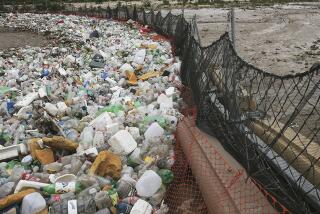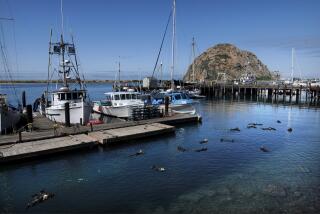O.C.’s Backup Outfall Offers Spill Insurance
- Share via
FOUNTAIN VALLEY — If a catastrophic break occurs in Orange County’s massive sewage outfall pipe like the one in San Diego, the shoreline would be better protected here because the county has an emergency backup line, county sanitation officials said Thursday.
The county can switch to an older undersea line if its regular pipe splits open. And much of the main line, which every day carries 220 million gallons of treated waste five miles off Huntington Beach, is couched in a bed of rock to protect it from waves and earthquakes.
“We’re in better shape than San Diego, with the stability of our pipe and the ability to divert into a second outfall,” said Corinne Clawson of the Orange County Sanitation Districts, which treat and dispose of the sewage of more than 2 million county residents.
Two smaller underwater pipelines that pump waste into the ocean off South County have no backups, but their potential for trouble is relatively small. Those pipes, run by two smaller sanitation districts, carry far less waste than Orange County’s huge outfall pipe, which handles 85% of the county’s sewage.
Also, the South County waste is treated more thoroughly than San Diego’s, so if the pipes rupture close to shore, there would be less bacteria, and it would not pose a serious health risk to swimmers, said Robert E. Merryman, director of the Environmental Health Department of the county Health Care Agency.
“It’s not really a problem for us,” Merryman said. “The Orange County Sanitation Districts (have) an alternative plan, and they handle the largest quantity. And in South County, they have (advanced) treatment, so we don’t have to worry about it as much as they do in San Diego.”
County officials said they sympathize with their San Diego colleagues, who are struggling with a broken pipe that has been dumping millions of gallons of partly treated sewage near the shore since Sunday.
San Diego officials said they believe that ruptures in 19 sections of the line were caused either by shifts of the ocean floor or by a gradual erosion from natural turbulence and low tide conditions.
“It’s a relief because it’s not us, but those people down there must be pulling their hair out,” said Linda Jones, assistant general manager of the South Coast Water District, which helps operate the small sewage outfall that pumps treated waste into the ocean about 1 1/2 miles off Aliso Pier in South Laguna. “It’s a massive repair project they have and a massive capital expense.”
Many sewage spills have occurred off the county, especially off Aliso Pier and near Doheny State Beach, because of equipment failures. But the three underwater lines in the county have not ruptured, despite offshore earthquakes and heavy storms.
Because San Diego has no alternate line, there is no way to divert the flow. Officials there could shut down the pipe to stem the flow, but then the toilets of 1.7 million people would back up with sewage.
Off Huntington Beach, however, a second line would be switched on, and waste would be pumped 1 1/2 miles offshore at an ocean depth of 63 feet. That’s closer to shore than the normal five miles and 200-foot depth but much better than the situation in San Diego. Normally, the San Diego waste is pumped 2.2 miles offshore into deep waters.
In December, a submarine inspection showed that the two Huntington Beach pipelines are in good condition, Clawson said. The pipes are inspected every three years, with the main goal of ensuring that hundreds of small portholes are not clogged with marine life, which could cause pressure to build.
“Our entire pipeline is laid in a bed of ballast rock, so it is stabilized,” Clawson said. “The inshore section, which is about 1 1/2 miles, is completely covered with the ballast rock, so it’s almost enclosed.”
San Diego’s line, however, is enclosed in ballast rock for only the first 2,500 feet from the shoreline. It broke at about 3,100 feet offshore.
The South County lines off Aliso Pier and Doheny State Beach are also embedded in rock and are inspected annually, said Bill Becker, general manager of the Aliso Water Management Agency and Southeast Regional Reclamation Authority, the two groups that own the outfalls.
When a 1988 inspection of the Doheny line showed weakened areas of ballast rock, the agency spent $1 million to correct it, he said.
“We inspect it every year to try to avoid that situation like in San Diego,” Becker said. “We spend $8,000 a year on that, which is expensive insurance.”
The Orange County Sanitation Districts’ emergency plan also calls for increased treatment and chlorination to kill disease-causing bacteria if a break occurs.
San Diego officials say they are not chlorinating their spillage because it endangers marine life, but Clawson said Orange County would not have similar concerns because there are no sensitive kelp beds off the Huntington Beach coast.
Merryman said he has no plans to augment the weekly testing of South County beaches because “the chances of it reaching here are very low, and there would be such a dilution factor.”
DOWN TO THE SEA
A sewage outfall line off Huntington Beach handles 85% of Orange County’s waste, discharging it five miles offshore after treatment. If that pipe breaks, the waste would be diverted to a second, older backup line. The rest of Orange County’s treated sewage is piped through two, much smaller lines that discharge into the ocean off Aliso Pier and Doheny State Beach. MAIN LINE Constructed: 1971 Diameter: 10 feet Waste load: 220 million gallons daily (675 acre feet, or enough to cover a square mile in sewage one foot deep) Discharge point: Five miles offshore Water depth: 200 feet
BACKUP LINE Constructed: 1954 Diameter: almost seven feet Discharge point: 1.5 miles offshore Water depth: 63 feet Source: Orange County Sanitation Districts
More to Read
Sign up for Essential California
The most important California stories and recommendations in your inbox every morning.
You may occasionally receive promotional content from the Los Angeles Times.













